Many modern RVs now feature roof-mounted solar panels and the accompanying electrical systems to store and convert solar energy for use with interior lights and appliances. But how much solar power does your RV need? And will your solar system provide enough?
The answer is a bit complex and, as you’d imagine, requires some math. But before we dive into the details, let’s talk about the essential components of an RV solar energy system.
How Should You Use Solar Energy in an RV?
Most RVers utilize solar panels to trickle charge their battery bank, not to provide power for an extended boondocking stay. Solar panels can also help you avoid over-discharging your batteries when you aren’t connected to a power hookup.
The power that comes from solar energy is in DC, which then must be inverted to AC to power AC appliances.
But, realistically, solar energy should be used to supplement your RV’s energy demands, as you would with a portable power station, an onboard generator, or a portable generator Yes, solar can be used to power an entire RV for a few days. But the limited roof space on most RVs makes installing the requisite number of panels for extended solar viability nearly impossible.
Generally, maximizing your RV’s solar potential is a matter of maximizing available roof space. If you want as much solar collection ability as possible, cover as much of your roof with solar panels as is safe and realistic.
Of course, you must retain space to access a fully walkable roof for repairs and your annual RV roof inspection. Your panels shouldn’t crowd existing roof accessories like your air conditioner and roof vents.
If you’re a full-time RVer that seeks long-term stays, you’ll have more freedom to employ portable solar panels or temporarily mount extra panels on the roof or the ground around your RV. Still, the efficiency of most solar panels makes installing enough – with the proper components – cost-prohibitive as a standalone power source for your RV.
Learn more about conserving and creating power when boondocking.
RV Solar Components
Here are the main components installed in RVs with solar capability – also known as solar prep. These components are necessary regardless of the size of your solar energy system.
Solar Panels
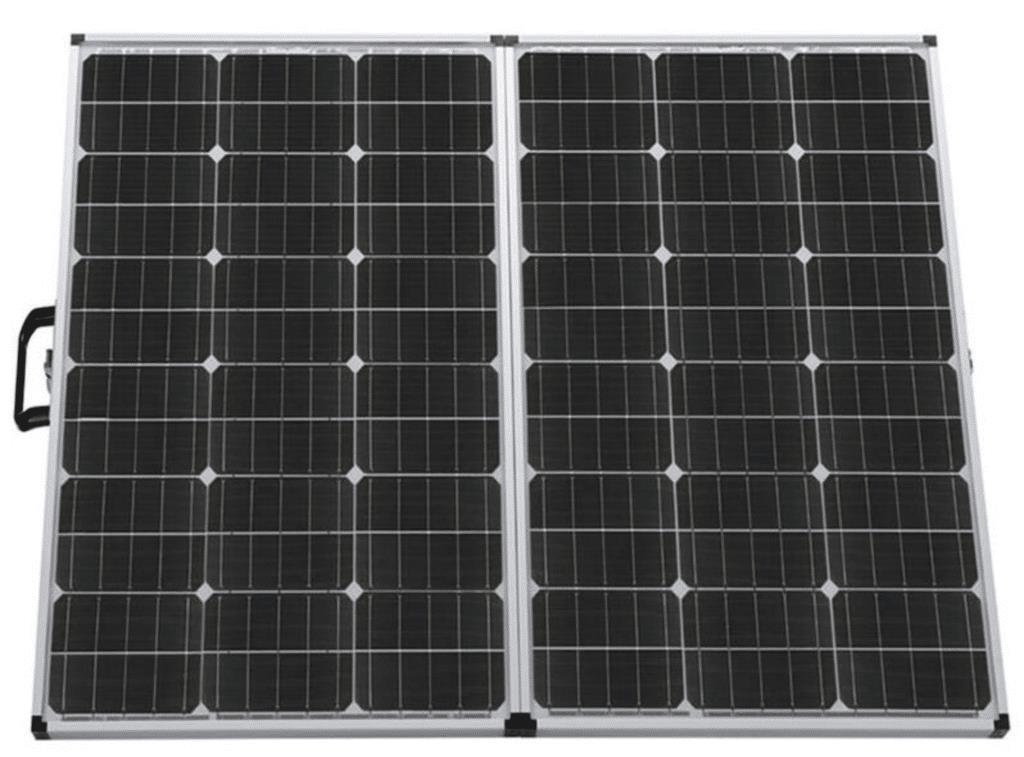
Photo by Camping World
Solar panels gather energy from the sun and send it through electrical wiring to your system’s charge controller. Adding solar panels allows you to gather more energy, but you may also need to upgrade other components to safely transfer and successfully store that energy.
There are two types of solar panels: monocrystalline and polycrystalline. Monocrystalline solar panels are more common for RVs because they provide more efficiency for the limited roof space you’ll have on most units.
Explore our selection of portable and mounted solar panels.
Solar Charge Controller
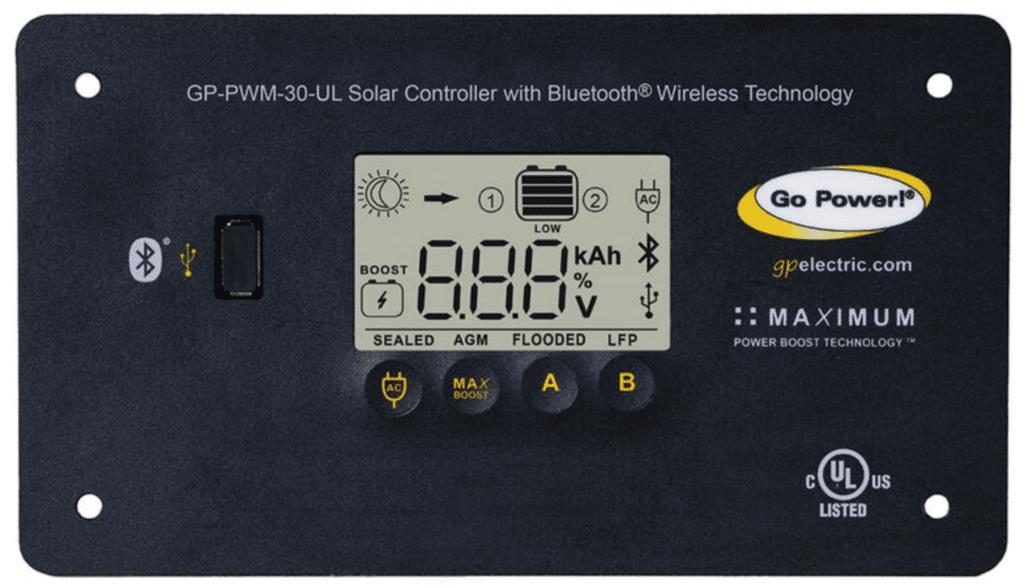
Photo by Camping World
A charge controller takes the energy that your solar panels harness and regulates it down to a useful voltage. The energy coming from your panels varies in voltage. A charge controller is essential for converting that voltage into the 12-15 volt range to properly charge your battery bank.
The two main types of solar charge controllers are maximum power point tracking (MPPT) and pulse width modulation (PWM). PWM controllers use older technology and are less efficient but are more affordable. MPPT controllers cost more, but they’re much more technologically advanced and will give you more long-term value for your investment.
Shop for solar chargers and controllers.
Batteries
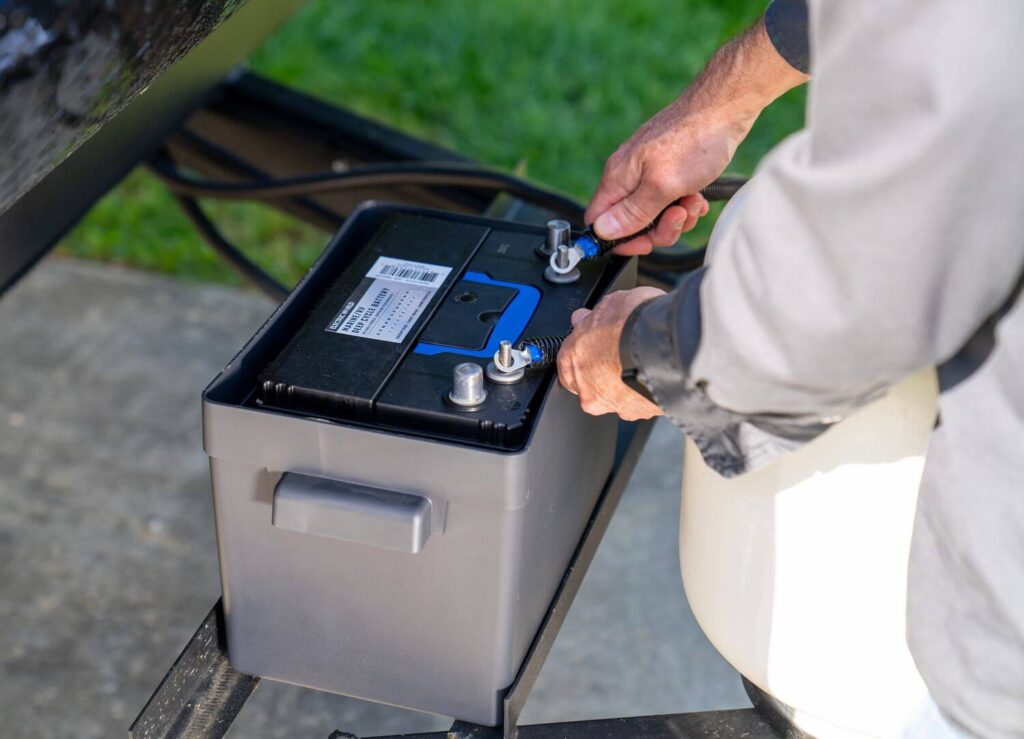
Photo by Camping World
Your battery bank provides the storage space for the energy your solar panels harness. They store energy until you switch on an RV appliance and demand energy from your batteries.
There are three main types of RV batteries: lead acid, absorbent glass mat (AGM), and lithium.
Lead acid batteries were the traditional standard, but AGM and lithium batteries are more commonly used in RVs with solar setups today.
Learn more about the pros and cons of the different types of RV batteries.
Inverter
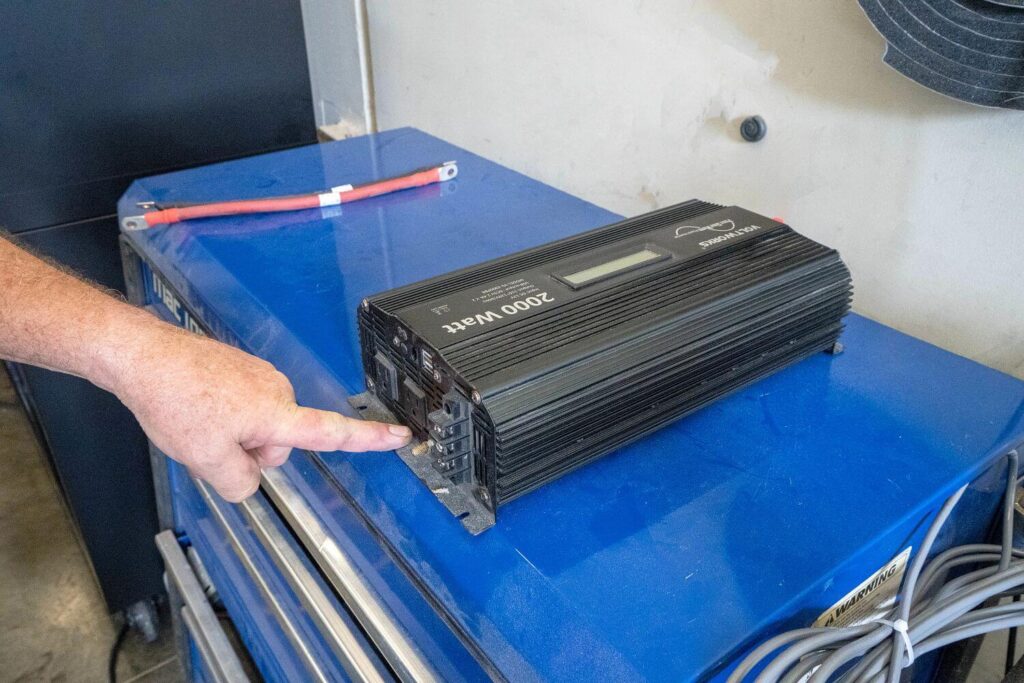
Photo by Camping World
An inverter takes the 12-volt energy stored in your batteries and converts it to 120-volt energy to serve outlets and appliances that require that voltage for safe operation. There are several different types of inverters, but RVs with solar should boast a pure sine wave inverter.
Pure sine wave inverters do the best job mimicking the power you’ll get with a household 120-volt plug. They provide the cleanest energy to reduce the risk of damaging sensitive electronics inside your RV.
Additionally, RVs prepped for solar are equipped with the proper electrical systems to help use the energy that your solar panels harness. These components include but aren’t limited to a battery monitor, battery isolator, bus bar, wires, fuses, breakers, switches, and outlets.
Contact our performance and improvement department if your RV is not prepped for solar and you want to explore your options for adding solar.
RV Solar Calculator
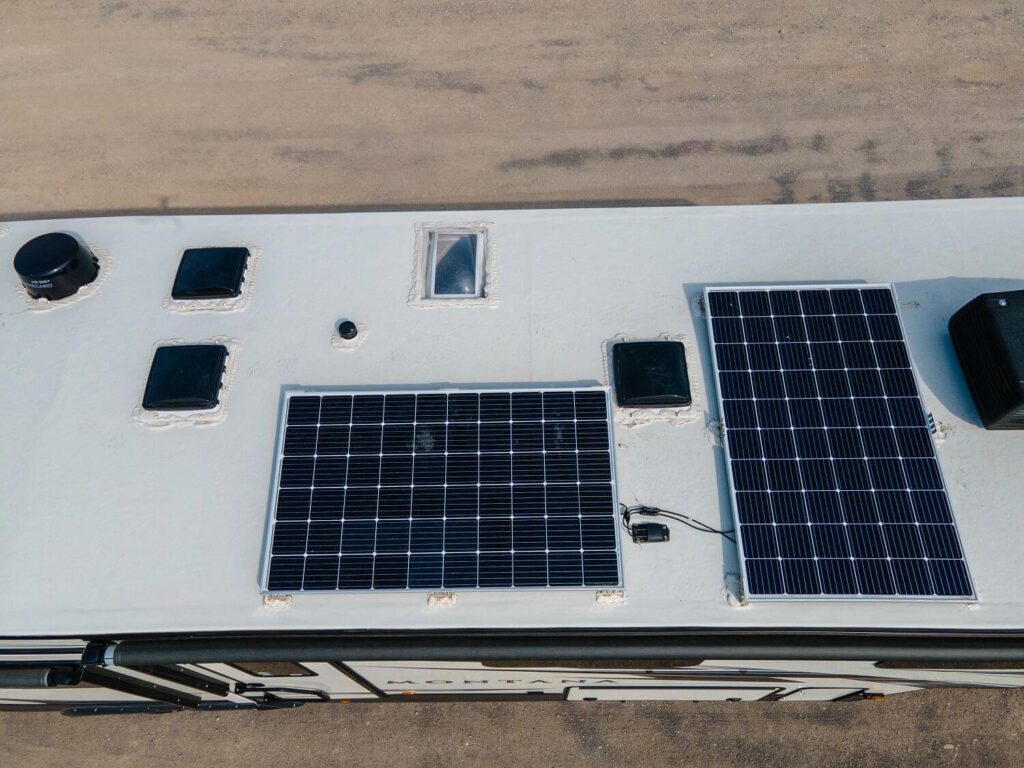
Photo by Camping World
So, how much solar do you really need for your RV? It’s time to crunch some numbers. Get out a pen, paper, and a calculator.
Record Wattage for Electronic Appliances and Devices
Your first step is to list all the devices and appliances that consume energy and record their running wattages. Your list should include appliances installed in your RV and devices you commonly plug into power outlets, such as hair dryers, toaster ovens, and phone/laptop chargers.
The wattage for your RV appliances is typically found in your owner’s manual, online, or on an identification sticker somewhere on the appliance.
If the wattage isn’t listed, you can solve for wattage using this equation:
Wattage = Amps x Volts
If your air conditioner pulls roughly 15 amps when running on 120-volt AC power, its running wattage is roughly 1,800 watts. It pulls more surge wattage when starting up, however.
Surge wattage accounts for the additional wattage needed to start the electrical motor or fan in appliances and generators.
Here’s an example of RV appliances and their respective wattages (yours will vary):
| Appliance | Watts |
| Air Conditioner | 1,000 |
| Microwave | 600 |
| Water Pump | 60 |
| Refrigerator | 1,000 |
| Coffee Maker | 1,000 |
| Hair Dryer | 1,500 |
Estimate Daily Usage Hours
Once you’ve listed your appliances and their wattage needs, revisit each device/appliance and estimate how many hours you’ll use them daily. You may run your air conditioner for 8-12 hours a day in the summer, but you’ll probably only run your microwave for a total of 5-10 minutes.
Go back through your list and add a column for usage hours next to each appliance.
Let’s add to our table above:
| Appliance | Watts | Usage Hours |
| Air Conditioner | 1,000 | 4 |
| Microwave | 600 | 0.25 |
| Water Pump | 60 | 1 |
| Refrigerator | 1,000 | 4 |
| Coffee Maker | 1,000 | 0.1 |
| Hair Dryer | 1,500 | 0.1 |
Select AC versus DC Power
Run back through your list and mark which appliances run on DC and which require AC. AC appliances require an inverter, as we mentioned above, and it’s important to factor in an average 10% efficiency loss for appliances that require an AC inverter.
That means a 1,000-watt air conditioner will actually require roughly 1,100 watts when running on power from an AC inverter. This comes into play later when calculating daily watt-hours.
We’ll amend our table to indicate AC versus DC appliances. Notice how the wattage changes slightly for AC appliances:
| Appliance | Power Source | Watts | Usage Hours |
| Air Conditioner | AC | 1,100 | 4 |
| Microwave | AC | 660 | 0.25 |
| Water Pump | DC | 60 | 1 |
| Refrigerator | AC | 1,100 | 4 |
| Coffee Maker | AC | 1,100 | 0.1 |
| Hair Dryer | AC | 1,650 | 0.1 |
Calculate Daily Watt-Hours of Energy Use
It’s time to calculate the total watt-hours of daily energy consumption you estimate for your off-grid adventures. This gives you the maximum amount of power you expect to use each day. For RVers that travel seasonally, certain climates require the use of additional appliances like space heaters or dehumidifiers.
Calculate your energy usage for all seasons to have the most accurate idea of how much solar you really need for your RV. Utilize the highest estimate when designing the ideal solar setup for year-round RV travel.
Let’s add watt-hours for each appliance, as well as a total calculation:
| Appliance | Power Source | Watts | Usage Hours | Watt Hours |
| Air Conditioner | AC | 1,100 | 4 | 4,400 |
| Microwave | AC | 660 | 0.25 | 165 |
| Water Pump | DC | 60 | 1 | 60 |
| Refrigerator | AC | 1,100 | 4 | 4,400 |
| Coffee Maker | AC | 1,100 | 0.1 | 110 |
| Hair Dryer | AC | 1,650 | 0.1 | 165 |
| Total Watt Hours | 9,300 |
Convert to Amp Hours
With your estimated watt hours known, you can calculate how many amp hours of energy storage capacity your battery bank must provide. To calculate watt hours, you’ll divide watt-hours by voltage.
Here are the results of our calculation:
| Appliance | Power Source | Watts | Usage Hours | Watt Hours |
| Air Conditioner | AC | 1,100 | 4 | 4,400 |
| Microwave | AC | 660 | 0.25 | 165 |
| Water Pump | DC | 60 | 1 | 60 |
| Refrigerator | AC | 1,100 | 4 | 4,400 |
| Coffee Maker | AC | 1,100 | 0.1 | 110 |
| Hair Dryer | AC | 1,650 | 0.1 | 165 |
| Total Watt Hours | 9,300 |
| Total Amp Hours | 775 |
How to Choose RV Solar Components
Now it’s time to use our calculations to select properly-rated components for our RV’s solar system.
Choose Your Battery Type
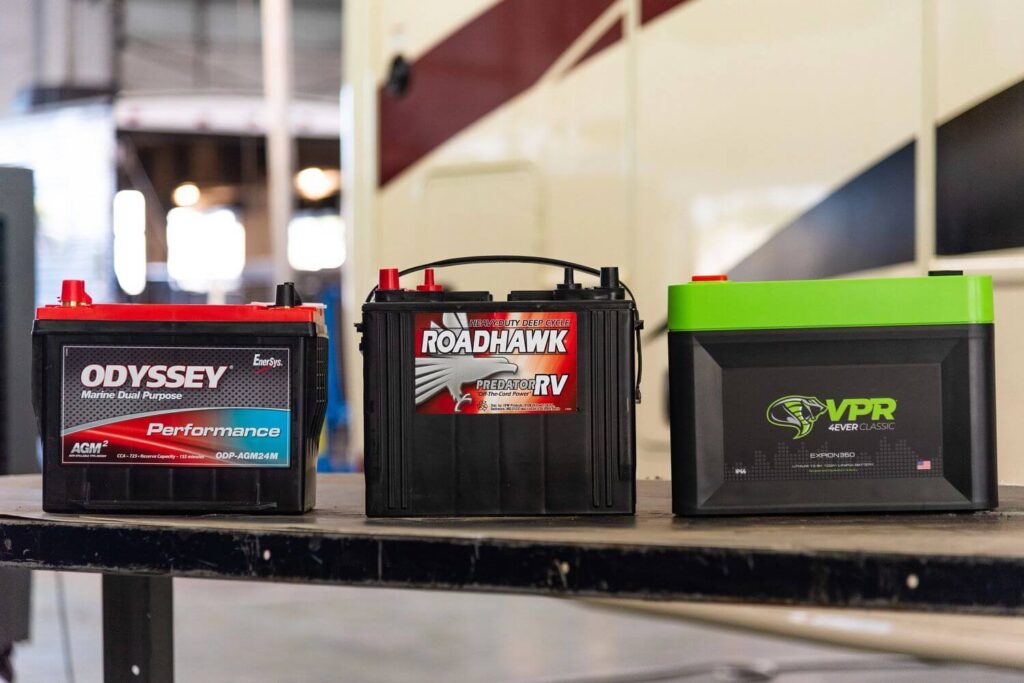
Photo by Camping World
Our total amp hours are our guide for choosing the right battery. Our choice will differ based on the type of battery we want.
For lithium batteries, it’s advised to avoid exceeding a depth of discharge of 80%.
That means we must add 20% to our total amp hours (775 x 1.2 = 930 amp hours). This converts to a lithium battery bank with a minimum of 11,160 watt-hours of power (930 x 12 = 11,160).
If we choose a 100 amp hour lithium battery, we’ll need 9.3 batteries to store all the energy consumed daily. You can see how that could be prohibitive, both in terms of storage space and cargo weight.
For AGM and lead acid batteries, we don’t want to exceed a depth of discharge of 50%, meaning we need to double our minimum amp hour threshold (775 x 2 = 1,550 amp hours). This converts to an AGM or lead acid battery with a minimum of 18,600 watt-hours of power (1,550 x 12 = 18,600)
If we choose a 100 amp hour AGM battery, we’d need 15.5 batteries to store the energy we consume daily. As your depth of discharge increases, you’ll require a larger battery bank (i.e., more energy storage capacity) to compensate.
Choose Your Inverter Size
Your optimal inverter size is based on the combined wattages of the appliances you plan to power with it. The combined wattages of our five AC appliances above total 5,730 watts. However, it’s safe to multiply by 1.5 to allow for startup wattage requirements (i.e., surge wattage).
So, in this use case, we’d recommend an inverter that can handle at least 8,595 watts.
Estimate Hours of Sun Exposure to Get Solar Panel Wattage
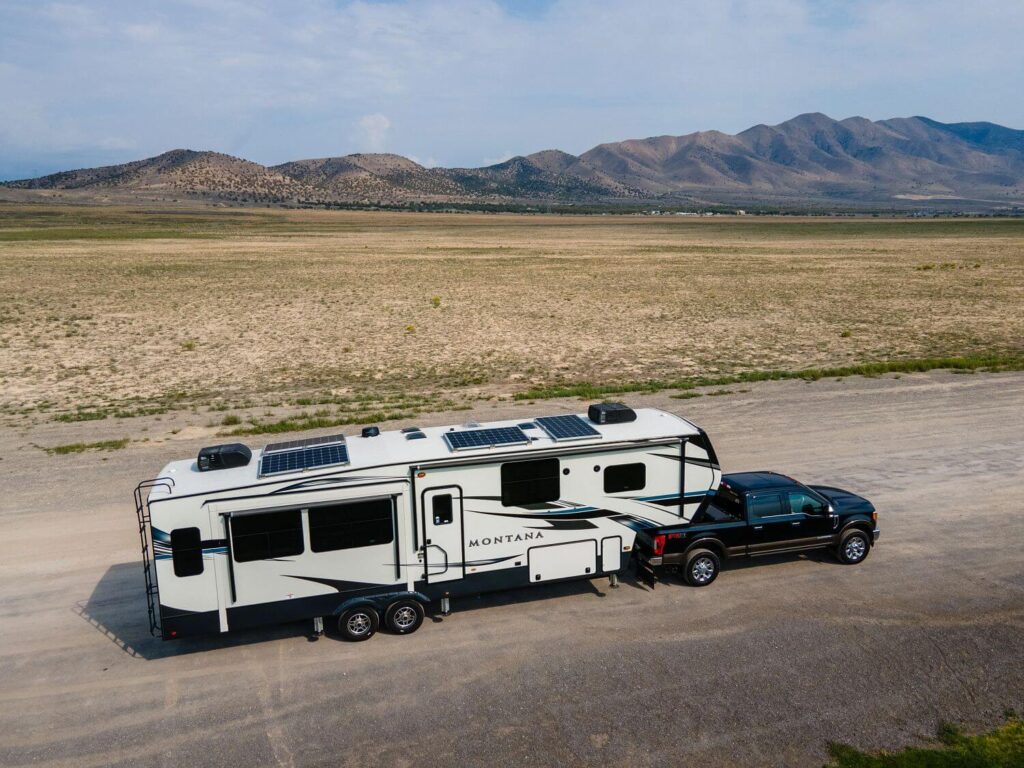
Photo by Camping World
Most solar experts recommend using four hours of sun exposure as a conservative estimate. Your actual number of sun hours depends on your location and exposure to direct sunlight.
In more southern locations like Arizona, you may receive closer to five to eight hours of direct sunlight. You’ll also increase your sun hours if your solar panels can tilt for an optimal angle as the sun moves across the sky.
To stick with a conservative estimate, let’s say you receive four hours of direct sunlight daily. To calculate how many watts of solar panels you’ll need, divide energy consumption (watt hours) by hours of sun exposure.
9,300 watt-hours / 4 hours = 2,325 watts
Considering the fact that most portable and roof-mounted RV solar panels capture between 80 and 440 watts, we’d need anywhere from six to 29 panels. It’s rare that RV roofs have enough space for this many panels, which is why we might also consider a portable generator or power station to supplement and recharge our RV’s battery bank.
Even if we reduced our energy demands to 3,500 watt-hours and we were camping somewhere with eight hours of daily sun exposure, we’d still require 440 watts of solar panels. That would require the roof space to install this complete solar kit from Nature Power.
Choose Your Charge Controller
Your charge controller must be rated to handle the wattage of your solar panels. A charge controller’s minimum amperage can be calculated by dividing your solar panel’s wattage by your battery bank’s voltage.
Continuing with our energy-intensive RV owner’s example from above, we’d divide our required 2,325 watts of solar panels by 12 volts to calculate an ideal charge controller amperage of 193.75. This means we’d need a minimum 190-amp charge controller to handle this kind of demand.
Our more energy-saving example would still require a minimum of a 35 amp charge controller (440 / 12).
How Much Solar Do You Really Need for Your RV?
If your RV is prepped for solar, but you don’t have any panels yet, consult your manufacturer for their recommendation. The components used in your solar prep will tell you how many watts of solar panels you can reasonably add.
In general, it’s recommended to have about 300 watts of solar panels for every 100 amp hours of battery bank capacity. That equates to a minimum of 600 watts for RVs with a 200 amp-hour battery capacity and a minimum of 1,200 watts for larger motorhomes and fifth wheels with 400 amp-hours of battery storage capacity.
Whether your RV is prepped for solar or you’re looking for a complete solar installation, our certified performance and improvement technicians are at your service. Contact our team to schedule an appointment today.
What questions do you have about adding solar panels to your RV? Let us know in the comments below.
The post How Much Solar Does Your RV Need? appeared first on Camping World Blog.
By: Tucker Ballister
Title: How Much Solar Does Your RV Need?
Sourced From: blog.campingworld.com/gear-and-accessories/how-much-solar-does-your-rv-need/
Published Date: Fri, 18 Aug 2023 08:00:00 +0000
---------------------------------------------
Did you miss our previous article...
https://outdoorsnewswire.com/camping/how-often-should-you-stop-on-a-road-trip
 CampingSurvivalistHuntingFishingExploringHikingPrivacy PolicyTerms And Conditions
CampingSurvivalistHuntingFishingExploringHikingPrivacy PolicyTerms And Conditions
